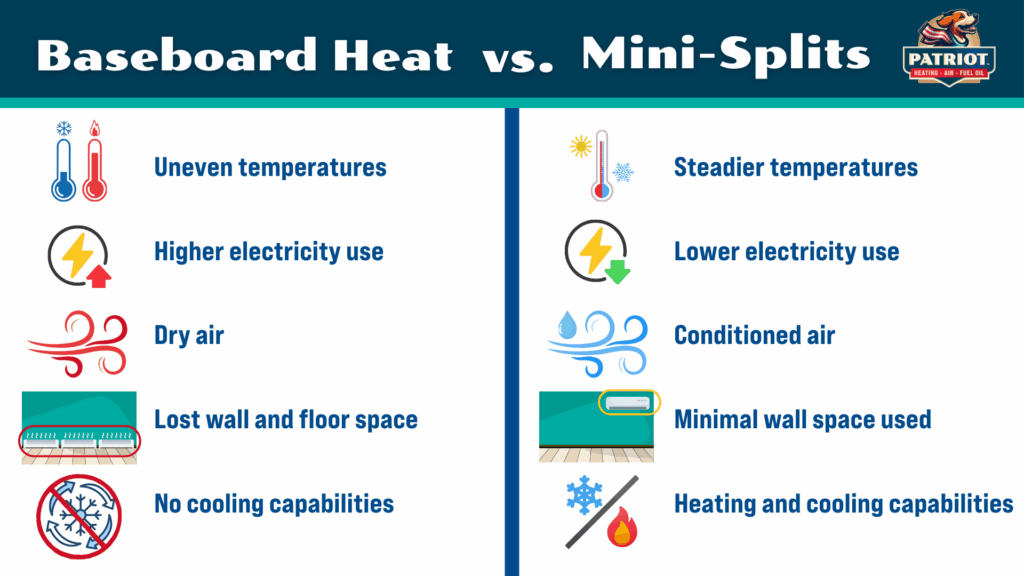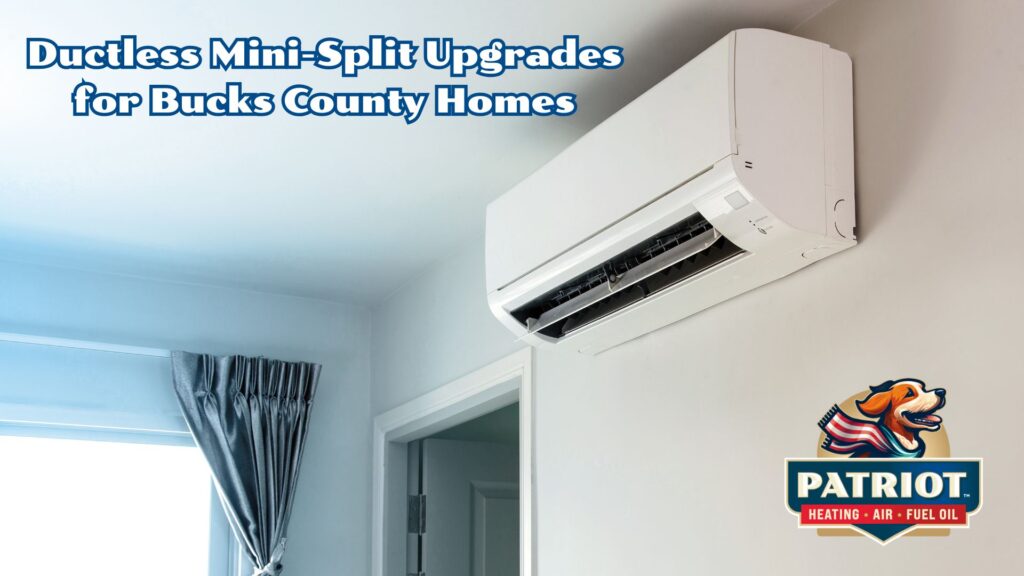If your Bucks County home relies on baseboard heat—common in Levittown capes, ranches, and additions—you’re not stuck with uneven temperatures and high electric bills forever. Ductless mini-splits offer zoned heating and cooling, quiet operation, and year-round comfort without tearing into walls for ductwork. Here’s how ductless systems compare, where they shine, and what installation looks like in an older home.
Why So Many Bucks County Homes Still Use Baseboard Heat
Many homes in Levittown, Bristol, and Bensalem were built without ductwork. Baseboard heat was a straightforward solution: simple to install, no ducts required, and reliable in mild-to-moderate winters. But baseboards can’t circulate air, don’t cool your home, and provide limited climate control beyond on/off and room-level thermostats. As comfort expectations and energy costs have changed, more homeowners are comparing mini-splits vs. baseboard heat as an upgrade that delivers better comfort and control.
The Everyday Drawbacks of Baseboard Heat
Baseboards can keep you warm, but they come with trade-offs compared to traditional HVAC systems:
- Uneven temperatures and slow response times across rooms and floors
- Higher electricity use compared with ductless heat pump technology over a season
- Dry air, lost wall space, and potential safety concerns around hot surfaces
- No built-in cooling for summer, often requiring window units or portable ACs
If any of these pain points sound familiar, you may be an ideal candidate for a ductless mini split installation.
How Ductless Mini-Splits Work (And Why They Shine in No-Duct Homes)
A ductless heat pump acts as both a heating and cooling system, pairing a compact outdoor unit with one or more sleek indoor “heads,” connected by small refrigerant lines. Each indoor head conditions the air right in the room, avoiding duct losses. Inverter-driven compressors modulate output to match the load, which means steadier temperatures, quieter operation, and fewer on/off spikes. During cooling, mini splits remove humidity effectively, improving comfort even at slightly higher thermostat settings. If cleaner air is a priority, ask about filtration and purification add-ons as part of your home’s indoor air quality plan.

Zoned Comfort: Room-By-Room Control That Baseboards Can’t Match
Zoned heating and cooling lets you control the temperature separately in different areas—cool bedrooms at night, a comfortable living room during the day, and energy-saving setbacks in seldom-used spaces. Ductless mini-split systems excel at solving hot/cold spots, reducing “thermostat wars,” and delivering targeted comfort to tricky rooms without existing ductwork like finished attics, basements, and sunrooms. Most systems include intuitive remotes or app controls with eco and night modes for easy scheduling.
Energy Efficiency and Cost of Ownership
One of the benefits of mini-split systems is that they avoid the energy loss that can occur in leaky or uninsulated ducted systems. Their variable-speed operation maintains temperature with less cycling, which can reduce wear and help control utility costs. Proper sizing and smart placement are key to maximizing efficiency in mini-split installation in older homes. Keep your investment performing with routine AC maintenance—clean filters, clean coils, and annual tune-ups keep your system running with strong airflow and high efficiency.
Ideal Use Cases in Older Homes: Garages and Additions, and More
Even if you have a traditional HVAC system for your home, installing a mini-split heat pump is a great option for additions and other rooms without ductwork:
- Garage mini split: A dedicated head can make workshops and hobby spaces usable year-round. Consider low-ambient heating models for winter comfort, and ensure the space is reasonably insulated to right-size the system. Moisture control is a bonus that’s especially helpful for tools and stored items.
- Mini-split for additions and sunrooms: Skip the cost and disruption of extending baseboards or adding ducts. A single indoor ductless air conditioner delivers precise, quiet comfort without remodeling.
- Finished attics and basements: Solve stratification and dampness with zoned conditioning and built-in dehumidification during cooling.
Depending on your layout, you might start with a single-zone system for the most uncomfortable room, then expand to a multi-zone plan as needs evolve.
What Installation Looks Like in a Finished, No-Duct House
A successful project starts with a site visit, heat-load calculation, and a head-placement strategy that balances aesthetics and airflow. Technicians plan discreet line-set routes, handle condensate management, and coordinate electrical work. Many single-zone projects are completed in a day; multi-zone installations add time but are still far less disruptive than running new ductwork.
Maintenance and Longevity
Homeowners can rinse or replace filters regularly and keep indoor and outdoor units clear of dust and debris. Annual professional service helps maintain efficiency, protects components, and verifies refrigerant charge and controls. With proper care, today’s systems are designed for durable, quiet performance across seasons.
When a Mini-Split Might Not Be the Only Answer
If your home has significant air leaks or minimal insulation, combining a ductless upgrade with weatherization can dramatically improve comfort and operating costs. For certain whole-home loads or unique floor plans, a hybrid approach—ductless for problem zones plus existing heat—can be the most practical path.
How Patriot Designs the Right Ductless Plan for Your Home
Patriot Heating, Air & Fuel Oil understands Bucks County housing stock, from Levittown capes to mid-century ranches and expanded additions. We’ll evaluate your goals, room-by-room needs, and electrical and aesthetic considerations, then provide clear options and pricing. Ready to trade baseboards for zoned comfort? Patriot serves Levittown, Bristol, Bensalem, and communities across Bucks County with straightforward recommendations and quality workmanship. Explore our ductless mini-split air conditioner installation services to get started.
Frequently Asked Questions
How many indoor heads will my Levittown cape need?
How many indoor heads you need will depend on your home’s layout, insulation, and how you use each space. Many capes start with two to three heads—often one for the main living area and one per sleeping level—then expand as needed.
Can one mini-split handle a garage or addition by itself?
Yes, one right-sized mini-split is often enough to handle a garage or addition. We’ll evaluate insulation, door sealing, and how you plan to use the space to size it correctly.
How long does mini-split installation take, and how disruptive is it?
Single-zone projects are commonly completed in a day. Multi-zone systems may take longer, but because there’s no ductwork build-out, the process is typically clean and minimally disruptive.
What does mini-split maintenance involve each year?
Annual mini-split maintenance involves regular filter cleaning, clearances around the outdoor unit, and a tune-up to check coils, electrical connections, condensate, and system performance. Professional maintenance helps protect efficiency and longevity.
Will a mini-split reduce my electric bill compared to baseboards?
Ductless heat pumps use inverter technology and condition rooms directly, which can help control electric usage compared to resistance baseboard heat. Actual savings vary with your home’s insulation, setpoints, and usage patterns.


